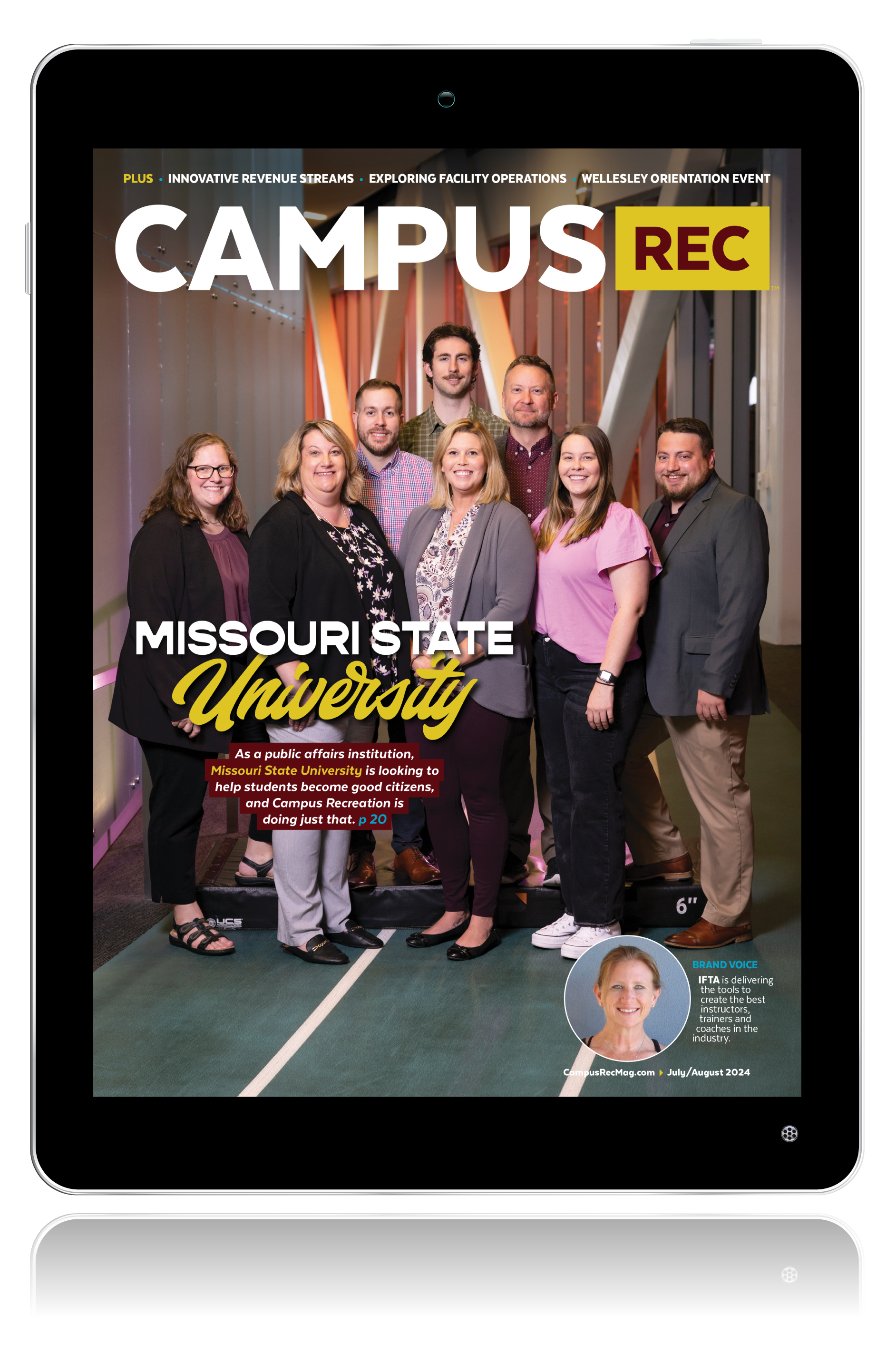Every day when I look in the mirror, I am reminded of a powerful and painful lesson I once learned about trust.
As many campus rec team leaders do, I took my staff for team-building exercises as a part of their training. The final activity on this particular day was a trust fall. In theory, this is an excellent activity for building teams. It is a tried-and-true idea that hits at some of our primal fears – abandonment, anxiety, loss of control, not to mention the entirely real possibility of falling on one’s head. To perform the activity, a person stands on an elevated position – such as a stage, stepping stool or tree stump – interlocks their arms, stiffens their bodies and falls directly back into the waiting arms of multiple people to catch them.
At least, that is how the activity is supposed to work when trust in a group is strong; however in this instance, the outcome was not as planned. I failed to take into account this group was not yet a well-functioning team. In fact, the individual on the platform was in her second day on the job and had not even met the rest of the group until that very day. Right before she fell back, she said, “Guys, I really don’t want to do this.”
At that moment it was apparent she did not have faith in our ability to keep her safe. Rather than take her feelings into account and work to build on that faith, we pressured her into going through with it anyway. As I was standing immediately by the platform I caught an elbow to the face as her arms flailed out as she was bailing out of the fall. Instead of a trust fall, we had a trust fail, and my first ever visit to the emergency room. For about two weeks, my nose was pointing in the wrong direction. Although I did have surgery to straighten my nose, it is still not straight to this day. The lesson was learned. Teams cannot thrive in the absence of trust.
A Common Flaw in Teams
Patrick Lencioni outlines this common flaw, the absence of trust, as the foundational issue teams must overcome in his book, “The Five Dysfunctions of a Team.” Groups with low trust have an unwillingness to be vulnerable within the group. They also have a hard time being honest about weakness and fear. Vulnerability is about being able to say and mean things like, “I need help” or “I am sorry.”
Team members who are not genuinely open make it impossible to build a foundation of trust. Lencioni states teams that lack trust tend to dread team meetings, are reluctant to take risks in asking for or offering assistance, morale is low, communication is poor, and turnover is high. To overcome this vulnerability issue over time requires shared experiences, following through on commitments especially in what you say you will do, and gaining an understanding of the unique attributes of the individuals on the team.
The Leader’s Role in Trust
As the leader, vulnerability starts with you. Strength has been associated as a positive leadership trait throughout history; however, humility may be just as important a trait in terms of predicting a leader’s success. The leader must model vulnerability in admitting mistakes and letting the team know when help is needed.
A part of this is recognizing your own emotions. You don’t want to take your bad days out on your team, or hide the fact you may be having the best day. Sometimes the best thing you can do is to share the context as it helps let the team know it’s not their fault. Emotions are OK. We all have them. It is important to try and understand the root cause rather than simply dismissing the emotions. If people know they can be vulnerable with you and open, it will unlock a whole new level in what is possible in the working relationship. Make things right when you are wrong and apologize. Be transparent and err on the side of disclosure. Open up about when you are not able to disclose when laws or ethics may prevent it.
Giving Trust to Get Trust
Trust is similar to respect in that it is reciprocal. One must give it to get it. Model trust in letting go of control and give your team a sense of autonomy. In the book “Radical Candor,” author Kim Scott states there can only be real trust if people feel “free” at work, resulting in people doing their best work. Openly convey belief in the capabilities of the group such as saying things like, “I believe in you” and “You have my support.” Trust cannot be counterfeit, meaning one cannot give people responsibility but not the authority or resources, or acting as though you trust someone and then micromanaging or hovering over them.
Will Rogers said, “There are three kinds of people: The ones that learn by reading. The few who learn by observation. The rest of them have to pee on the electric fence for themselves.” Sometimes, it takes an elbow to the face to help you learn the important lesson. As a leader, I should have been the one on the platform modeling the way and putting myself in a vulnerable situation, demonstrating confidence and the trust in the team and showing them it would be alright, and that it was safe to do. A common phrase is “trust the process;” maybe it should be “make sure trust is the start of the process.”
Image Courtesy of Shutterstock











